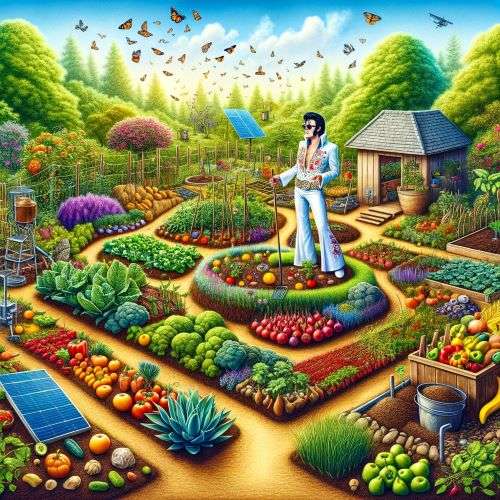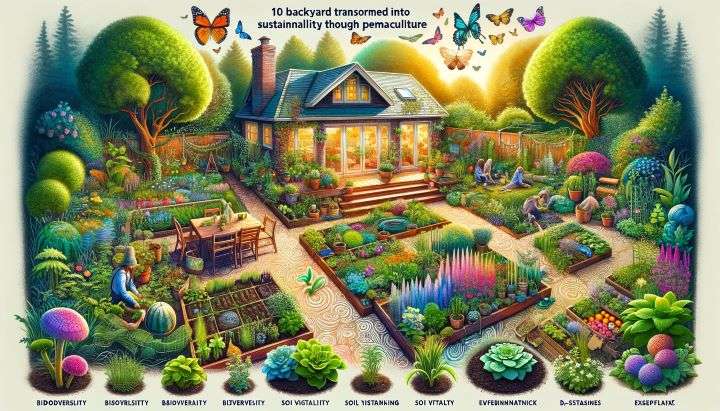This post contains affiliate links, through which we may earn a commission at no additional cost to you.
Table of Contents
Introduction
Join us on a captivating venture into the core of food forests and magical landscapes where the concerto of nature’s assembly resonates distinctly with every whisper of the leaves, every flowering, and each step you take. These lush refuges reveal the earth’s-old knowledge, enlightening us on living in harmony, demonstrating resilience, and thriving in plenty. Food forests are more than an alternative farming method; they are living proof of what is achievable when we align our lives with the natural world’s rhythms, utilizing the innate capabilities of varied species to foster a self-reliant food production ecosystem.
They epitomize the zenith of ecological architecture, with each component having a role, all contributing to a harmoniously productive equilibrium. As we further explore the quintessence of food forests, we encourage you to broaden your perspectives towards agriculture as a vital act, a strategy to mend the Earth while providing nourishment for our bodies and spirits. Venturing into the dynamic universe of food forests, we are on the brink of redefining our interaction with the Earth. Food forests represent not just a method but a life philosophy, a creed where mutual assistance, variety, and natural cycles set the cultivation tempo.
The Layered Wonders
Beyond the Canopy: Diverse Ecosystems of Food Forests Unveiled
The effectiveness and beauty of food forests stem not solely from their appearance but also their ecological productivity and diversity. In contrast to traditional gardening, food forests adopt a layered structure that replicates natural ecosystems. This results in a self-sufficient habitat enriched with biodiversity. The intricacy of this setup includes seven separate layers:
- The uppermost canopy
- The sub-canopy of smaller trees
- The bush layer
- Herbaceous plants
- Soil-covering plants
- The root area
- A vertical layer consisting of climbers and vines
This organization is more than just visually appealing; it serves as a model of ecological excellence.
A vital tactic in nurturing a flourishing food forest is to integrate plants that fix nitrogen, such as beans, alongside taller fruit-bearing trees. This partnership naturally enriches the soil, negating the need for artificial fertilizers and eliminating runs to the gardening shop. The variety in a food forest goes beyond plant assortment, covering the adaptation to different environmental conditions such as tropical, temperate, desert, and urban areas.
Tropical Food Forests
Thriving in year-long growing conditions, tropical food forests boast ample biodiversity. These zones are perfect for a variety of fruit trees, like mangoes, avocados, and papayas, making up the canopy. Below them, undergrowth species such as bananas and pineapples prosper. A humid and warm atmosphere supports a luxuriant herb layer populated with edibles, spices, and medicinal plants, further aiding soil conservation and maintaining moisture. The successful cultivation in tropical food forests relies heavily on utilizing heavy rainfall and rich biodiversity to foster a dense, yielding ecosystem.
Temperate Food Forests
Temperate food forests adapt to their environment’s seasonal shifts and cooler temperatures with a distinct growth strategy. Deciduous trees like apples, pears, and cherries form the canopy, offering shade during summer and allowing light through during winter. Trees providing nuts and berries augment this layer, accompanied by various shrubs and perennial vegetables that thrive in colder weather. Here, the focus is on selecting plant species that endure frost and may profit from colder temperatures to bear fruit.
Food Forests in the Desert
Contrary to what one might expect, it’s entirely feasible to establish a food forest in desert conditions through careful design and water management. These food forests focus on species resilient to drought and high temperatures. The canopy may feature date palms and figs, with pomegranates and jujubes adding secondary productivity. Swales and mulch are essential for water retention, and the ground is usually covered with resilient succulents that shade and minimize soil moisture loss.
Urban Food Forests
Urban food forests adjust food forest principles to fit city environments’ limited spaces and possibilities. They can transform unused urban plots, park boundaries, and rooftop gardens into productive areas. Here, the strategy often involves vertical growing techniques to optimize space, employing trellises and walls for climbing plants. Edible perennials, miniature fruit trees, and herbs are incorporated within city greenspaces to beautify, boost biodiversity, and reconnect city inhabitants with nature.
Implementing food forests across diverse climates and locales showcases the adaptability and resilience of this sustainable farming approach. By emulating natural ecosystems and making the most of ecological interactions, food forests chart a course toward resilient, fruitful, and biodiversity landscapes. These landscapes thrive synchrony with their environment, whether amidst the lushness of the tropics, the dynamic seasons of temperate zones, the arid deserts, or the urban sprawl, standing as testaments to sustainability and ecological balance.
The Power Couples of Plant Companionship
The Craft of Companion Planting in Varied Edible Forest Settings
Ignite the superficial bonds of dating apps; genuine synergy and collective improvement are discovered in the lush layers of edible forests. The age-old companion planting technique serves as a reminder of nature’s harmonious connections, with different plant species paired to boost their growth, defense, and yield. It’s like arranging a well-thought-out botanical gathering, where each guest enhances the group, resulting in a harmony of ecological equilibrium and abundance. Here, we explore the implementation of companion planting in diverse edible forest settings, from the moist tropical regions to the concrete urban environments.
Tropical Edible Forests: Melody of Scents and Tastes
Companion planting proves critical for enhancing variety and output in the moisture-rich environments of tropical edible forests. The thick canopy of fruit trees, like mango and coconut, lives in harmony with understory crops, such as coffee and cacao, which favor the patchy sunlight. Smaller allies, including turmeric and ginger, flourish here, their pungent roots keeping pests at bay and infusing the soil with antimicrobial qualities. Marigolds and other blooming flora weave through this lush mosaic, their striking flowers adding beauty and fending off insect predators with their strong odors. This biodiverse haven is the epitome of companion planting, building a robust ecosystem where each element nurtures the next.
Temperate Edible Forests: The Cycle of Mutual Support
In the temperate zones, dictated by seasonal rhythms, companion planting adopts a pivotal role in edible forests. Leaf-shedding fruit trees, such as apples and pears, create the upper strata, their discarded foliage enriching the earth for nitrogen-enhancing legumes like peas and beans to intertwine around their bases. Aromatic herbs such as basil and thyme, mingling with strawberries and leafy vegetables, use their scents to repel pests while improving the taste of their neighboring fruits. Garlic and chives, positioned near roses and fruit shrubs, defend against aphids with their sulfurous emissions. This seasonal rotation of species fosters a robust ecosystem and secures a harvest all year.
Desert Edible Forests: Lifelines of Mutual Dependence
In the arid landscapes of the desert, companion planting acts as a crucial survival strategy, turning barren terrains into flourishing oases. Resilient date palms and fig trees conserve shadow and moisture for ground-level crops such as pomegranates and apricots, which delve deep for water sources. Aloe vera and other succulents spread below, their water-laden leaves cooling the earth and offering sanctuary for helpful insects. Nitrogen-enriching bushes weave through this dry mosaic, preparing the soil for groundcovers fighting dust and conserving vital moisture. In these conditions, companionship is not merely advantageous; it’s essential for endurance.
Urban Edible Forests: The City’s Lush Allies
Among the concrete and metal of cityscapes, edible forests stand as pillars of biological diversity and ecological synergy. Rooftop gardens and transformed plots are home to companion plants, with climbing beans rising beside tomatoes, their combined strength epitomizing the essence of urban companion planting. Marigolds and nasturtiums thread through the vegetation, their vivid blossoms warding off pests and luring pollinators in the city wilderness. Herbs like rosemary and mint, planted along walkways, provide pleasant fragrances and act as natural insect repellents. In these crowded spaces, companion planting amplifies produce and creates a microclimate of variety, infusing the urban heart with nature’s resilience.
The tradition of companion planting, with its varied forms across different ecosystems, illustrates the value of observing and mimicking nature. Whether it’s the unlimited diversity of the tropics, the seasonal dynamics of temperate zones, the severe challenges of the desert, or the restricted vitality of urban locales, companion planting underscores the principle that strength lies in diversity. It represents a comprehensive strategy that generates an abundance of food and fosters resilience, beauty, and ecological balance in the collective celebration of plant synergies.
The Subterranean Hub Secrets B
Uncovering the Secrets Beneath The Dynamic World of Microbial Collaboration in Food Forests
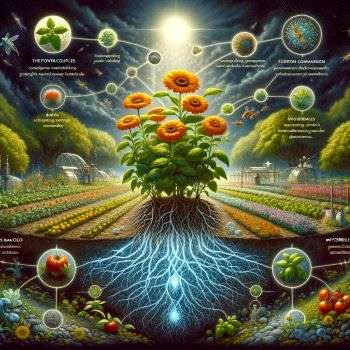
Underneath the lush greenery and fertile layers of a food forest, a hidden kingdom thrives, as intricate and vibrant as a bustling urban city above ground. This underground realm is filled with diverse microorganisms, each playing an essential role in ensuring the health and productivity of the surrounding ecosystem. Fungi, particularly those forming symbiotic relationships with plant roots like mycorrhizal fungi, are notable for their role in managing communication and the exchange of resources. These interactions are fundamental to the resilience of food forests, allowing for an effective transfer of nutrients and sugars between the fungi and plants. Beyond nutrient exchange, this underground network is pivotal for the robustness and sustainability it brings to the ecosystem.
The Mycorrhizal Network: Facilitating Underworld Cooperation
Mycorrhizal fungi serve as the soil’s internet, linking plants through an extensive network of hyphal filaments. This complex system allows for the efficient movement of water, nitrogen, phosphorus, and other vital minerals straight to the plant roots, sometimes reaching areas far beyond their usual span. In return, plants supply these fungi with carbohydrates created from photosynthesis. This reciprocal arrangement mirrors a bartering system, mutually benefiting both sides by promoting growth and health. Impressively, this fungal network enables plants to share resources and signal each other about potential pests and diseases, initiating timely defensive measures among the connected flora.
Boosting Resilience and Fruitfulness
A strong mycorrhizal network hidden under the food forest floor significantly elevates its resilience and fruitfulness. This underground partnership improves nutrient absorption and water uptake, making plants more resilient against drought, nutrient deficiencies, and pest attacks. Moreover, the network aids in soil structure and fertility, with hyphal threads forming micro aggregates that enhance aeration, retain water, and prevent soil erosion. This complex interplay of life ensures the food forest’s prosperity with minimal external inputs, showcasing the essence of sustainability and ecological harmony.
Fostering a Rich Microbial Habitat
Beyond mycorrhizal fungi, the earth beneath a food forest buzzes with microbial life, from bacteria and protozoa to nematodes, which all assist in breaking down organic material and recycling nutrients. This microbial diversity is crucial for decomposing dead plants, transforming them into nutrient-rich humus, and making these nutrients available to living plants again. Beneficial bacteria play a vital role by converting the nitrogen in the air into a usable form for plants can absorb, thus naturally fertilizing the soil and lessening reliance on chemical inputs.
The Importance of Organic Material and Mulching
Incorporating organic material and practicing mulching are essential activities for supporting this vibrant underground community. Organic matter feeds the soil’s organisms, spurring microbial activity and diversity. At the same time, applying mulch serves to stabilize soil temperatures, preserve moisture, and deter weed growth, all of which fosters an ideal habitat for developing microorganisms. These strategies collectively enrich the soil, transforming it into a fertile and active foundation that bolsters the growth of the food forest overhead.
In summary, the dynamic and unseen city underneath a food forest’s terrain illuminates the complexity and interconnection of natural ecosystems. The symbiotic relationships, the cycling of nutrients, and the communication pathways among plants and microorganisms highlight the critical importance of soil health. Serving as the living bedrock, it fuels the ecosystem’s energy, resilience, and productivity, reflecting the unseen magic sustaining thriving food forests. By nurturing these below-ground connections, we can tap into our food forests’ full potential, ensuring their enduring health and abundance for future generations.
Visual Feasts for Consideration
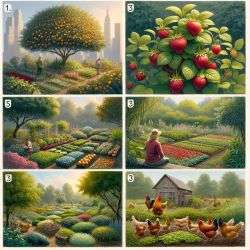
- Metropolitan Sanctuary: Convert a compact backyard into a multi-layered bounty of fruit trees, berry shrubs, and edible ground cover. Visualize a peach tree canopy with strawberries blanketing the ground, an enchanting scene that could induce joy in a gnome.
- Suburban Paradise: A plot of moderate size can be turned into a diversity-rich sanctuary with apple trees, asparagus ferns, and climbing peas. It’s akin to throwing a plant-centric fiesta with an open invitation to all.
- Countryside Haven: For those blessed with ample land, mixing nut trees with areas for chicken grazing establishes a self-sustaining cycle. Chickens mitigate pests and enrich the soil while enjoying a diversified diet. This scenario creates mutual benefits and the bonus of fresh eggs for your morning meal.
Essential Reads
- “Edible Forest Gardens” by Dave Jacke and Eric Toensmeier offers a comprehensive exploration into food forest design, from soil composition to selecting vegetation. Imagine it as the gardener’s Lord of the Rings, minus any monstrous creatures.
- “The Forest Garden Greenhouse” by Jerome Osentowski reimagines greenhouses, extending their utility beyond tomatoes. Osentowski demonstrates how a tropical haven can be established in your backyard, showing that climate is not an obstacle in cultivating your food forest.
- “The Food Forest Handbook: Design and Manage a Home-Scale Perennial Polyculture Garden” by Darrel Frey and Michelle Czolba presents an all-inclusive manual for devising and overseeing a home-scale polyculture garden. It offers actionable insights for crafting a food forest that is as productive as it is sustainable.
Top 5 Must-Haves for Your Food Forest
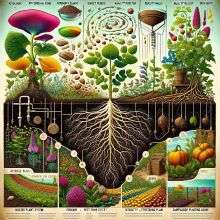
- Mycorrhizal Fungi Inoculant: Kickstart your soil’s subterranean community and observe your plants flourish. Think of it as your garden’s social network, minus any unsettling drama.
- Nitrogen-Fixing Plant Seeds: These seeds are a selection of beans, peas, and clovers that naturally fortify your soil. They’re akin to a green thumb’s daily supplement.
- Drip Irrigation System: Effortlessly maintain hydration levels in your food forest. It’s as though you’re providing a self-service buffet for your plants.
- Quality Mulch: Safeguard and enrich your soil, preserving its moisture and fertility. Consider it the snug blanket your garden has always longed for.
- Companion Planting Guide: An exhaustive chart detailing which plants thrive when situated next to each other. It’s the ultimate hack for ensuring peaceful plant coexistence.
Conclusion: A Haven Brimming with Edibles and Joy
Initiating developing a food forest in diverse climatic conditions transforms gardening into an exciting journey of discovering natural synchronization and plenty. This endeavor goes beyond just planting and reaping; it involves establishing a mutual relationship with the Earth. Every plant, microorganism, and ecosystem component works together to foster a self-maintaining habitat. By adopting food forestry principles in your garden work, you partake in a comprehensive method that surpasses conventional farming methods. You evolve into a guardian of a section of the planet bursting with life, variety, and yield.
This venture is an open invitation to watch, engage, and integrate into the complex life network, altering your role from a mere grower to an active participant in the ecological equilibrium dance. Every piece of land in tropical areas, temperate regions, deserts, or city settings can morph into a lush food forest filled with rich harvests and ecological robustness. Within the food forests domain, abundance transcends crop yield; it involves the wealth of biological diversity, ecosystem health, and the happiness derived from communal natural bounty sharing.
Adopting companion planting principles, mycorrhizal associations, and the layered structure of food forests aids in advancing a regenerative farming culture that repairs the terrain while sustaining its stewards. Developing food forests is a continuous celebration of existence, growth, and concord, where every flora, fauna, and human plays a part in crafting a resilient, productive ecosystem tapestry. Therefore, as you prepare to let your garden go wild, remember you’re on a revolutionary path. In the food forest world, abundance isn’t merely an aim; it’s the expected result of collaborating closely with nature, where every changing season unveils new teachings, development, and reasons to rejoice in Earth’s life abundance.
Frequently Asked Questions (FAQs)
How do you water a food forest in arid or desert climates?
Utilize drip irrigation or olla pots for efficient water use and to minimize evaporation.
Can food forests thrive in cold, temperate climates?
Yes, by selecting cold-hardy species and using microclimate strategies to protect plants.
What are the best plants for an urban food forest?
Choose compact, high-yield varieties like dwarf fruit trees, berry bushes, and vertical climbers.



